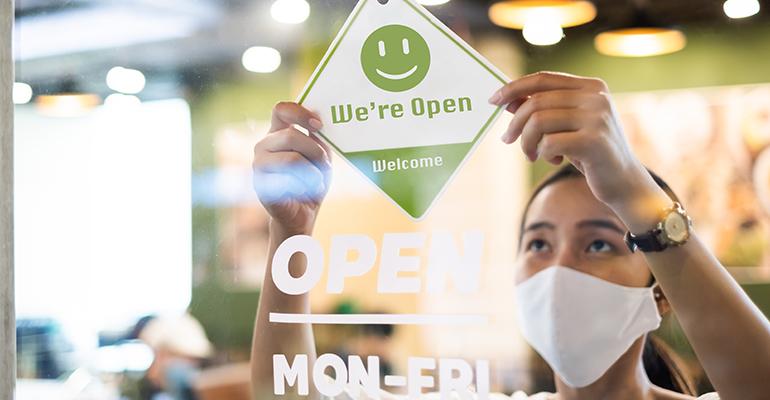Now that most full-service restaurants in the U.S., Canada and the U.K. are gearing up to reopen at 100% capacity after 12 months in mothballs, it’s time for a hard reckoning: Are you truly ready, willing and able to get back in the game? And if so, what are the new rules?
Over a year ago, quick-serve restaurants in the U.S. learned to pivot, adapt, and evolve their operations and people skills in real-time in response to the pandemic challenge. Some likened it to “laying track while the train is running.”
Full-service restaurants have not been put through their paces in quite some time, having been saddled with lots of false starts and limited openings. But the next 30 days will likely transform that forced exile into a welcoming return as government restrictions ease, vaccinations help the population reach herd immunity, and customers start venturing out to drink at bars and eat in restaurants in greater numbers again. (Of course, if you operated bars in a Spring Break destination you can ignore that last sentence).
The return to full-service operations will most likely begin as a trickle and end as a flood over the next six months as the pent-up demand to eat, drink and be merry will return.
But don’t presume that every boat will be lifted by this incoming tide.
“I advise our managers that we need to be sharp and alert now and that all our teams be engaged and clear on their roles so they don’t practice on our guests,” says Emmy Scott, director of employee engagement and culture branding for Homegrown Hospitality Group in Charleston, S.C., which operates eight concepts and 23 locations in three states. “We have to shake off the ‘COVID-coma’ that might have settled in when we were not at full-capacity, forced to suddenly close and open again, and hire new people to replace veteran team members who had to move on. Guests will be more discerning in who they choose to spend money with and if we can’t operate at peak performance, they’ll seek out competitors who can. Complacency is not an alternative, hope is not a strategy and business-as-usual is not an option.”
Yes, “COVID-coma” is a thing. And it’s characterized by the inability to open daily being sharp, focused, clean and ready after a year of being sedentary.
It can happen to any full-service restaurant when COVID causes complacency to overtake urgency and weariness replaces intensity. Instead of playing to win, we end up playing not to lose.
A year of inaction and being relegated to the sidelines can cause standards to slide, systems to falter, rust to accumulate, and teams to be distracted, accepting less than who we are and half of what we profess to be.
Management becomes reactive instead of proactive, and, as customers migrate away, management starts blaming circumstance instead of their own failure to sharpen the saw and be rush-ready everyday.
To paraphrase Danny Meyer, this last year has given us a once-in-a-lifetime opportunity to lift the entire company ship out of the water, scrape the barnacles, inspect and repair the hull, realign the rudder, replace the sails and make it seaworthy for a post-COVID marketplace.
As I’ve slowly ventured back out into restaurants and bars this past month, I recognize the “COVID-coma” Emmy has identified. You can feel the lack of energy and creeping clutter in many reopened restaurants. I’ve noticed servers and bartenders treating customers as an interruption of their job instead of the reason for it and managers overlooking the details; no longer seeing the paper on the floor, the full trashcan behind the host stand and the guest who needs assistance when the waiter can’t be found.
Here a few questions to ask yourself to help your restaurant to shake the COVID-coma:
- Have you redefined your standards, realigned your process, and recommitted your teams for the New Times? Is everyone clear on what their responsibilities are? How do you know for sure?
- If you were starting from scratch how would you reimagine and improve your systems, hiring process, training, customer service, takeout? What do your customers want and expect differently now than they did one year ago? Have you invested in improving the digital literacy of your managers and above-store leaders?
- Have you conducted a Customer Contact Point (CCP) audit recently and assessed your readiness and performance grade? List all the ways the guest interacts (chronologically) with your restaurant. Specify what kind of actions/results at each CCP the guest would consider above average, average or below average. Start with your website, apps, parking lots, front doors, entrances, greetings, host stands, pickup/to-go area, bar, dining room, tabletops, bathrooms, payment, farewell, loyalty club, etc. Identify potential combustion points in your CCPs and detail ways to make them non-problematic. The notion is to rediscover your restaurants through the eyes of the guest daily and blow off the COVID-coma blinders. Refresh, renew, and shoot for habitual consistency in operations.
- Have you deep-cleaned everything? This starts with the host stand most importantly since seating and pickup orders originates here. What does the guest see that you've stopped seeing? As Ray Kroc said: “Clean the corners and the middle will take care of itself.” You sell more in a clean restaurant.
This process is simple, costs nothing, and should help you re-earn the patronage of your guests, both old and new. But to do nothing is to walk backwards.
Jim Sullivan is a speaker, webinar leader, and the author of two bestselling books: “Multiunit Leadership” and “Fundamentals” You can learn more at MultiunitLeadership.com.





